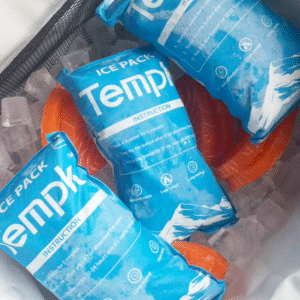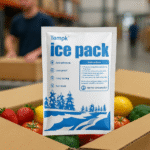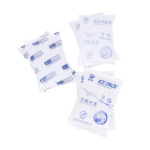Paquetes de hielo seco vs gel: Which Lasts Longer in Cold Chain Shipping?
Cuando se trata de productos de envío de productos sensibles a la temperatura, understanding which refrigerant—Paquetes de hielo o gel—lasts longer is crucial for ensuring the safe delivery of goods. En este artículo, we will break down the key differences between these two cooling methods, their longevity, and the scenarios where each is most suitable for use in cold chain logistics. With proper knowledge, you can make informed decisions to ensure your products reach their destination at the required temperature.
-
Que es el hielo seco, and how does it work for shipping?
-
How do gel packs compare to dry ice for long-lasting cooling?
-
Which cooling solution is more suitable for different shipping conditions?
-
What are the latest trends in cold chain logistics for 2025?
Que es el hielo seco, and How Does It Work for Shipping?
El hielo seco es la forma sólida de dióxido de carbono (Co₂) that sublimates directly from a solid state into a gas at a temperature of -78.5°C (-109.3°F). This ultra-low temperature makes dry ice an excellent option for maintaining extremely cold temperatures during the shipment of perishable items such as pharmaceuticals, muestras biológicas, y alimentos congelados.
Dry ice works through sublimation, which means it transforms from a solid directly into gas, absorbing significant amounts of heat. It is particularly effective when used with proper insulation, helping shipments maintain freezing conditions for long durations. Dry ice is commonly used for shipments requiring deep-freezing, como las vacunas, helado, y carne, due to its ability to maintain temperatures well below freezing.
Paquetes de hielo seco vs gel: ¿Cuánto dura el hielo seco??
Dry ice has a longer cooling duration compared to many alternatives, incluyendo paquetes de gel, thanks to its extremely low temperature. De término medio, dry ice can last anywhere from 18 a 72 horas, depending on various factors like the amount of dry ice used, the packaging, and the insulation involved.
| Factor | Duración de hielo seco | Gel Pack Duration | Practical Significance |
|---|---|---|---|
| Duración de envío | 18-72 horas | 12-48 horas | Longer durations for dry ice |
| Tipo de producto | Productos farmacéuticos, alimento | Bocadillos, muestras medicas | Best suited for medical goods |
| Control de temperatura | -78.5°C | 0° C a 5 ° C | Dry ice provides colder temperatures |
Insight clave: Dry ice lasts longer than gel packs, especially for products requiring low temperatures over extended periods.
¿Qué son los paquetes de gel?, and How Do They Compare to Dry Ice?
Gel packs are flexible pouches filled with a gel solution that freezes at temperatures around 0°C. These are typically used for products that require refrigeration but not freezing, como productos frescos, lácteos, y ciertos medicamentos.
Although gel packs are convenient for short-term shipping, they do not last as long as dry ice. Gel packs are better for shipments requiring a mild, controlled temperature range (usually between 1°C and 5°C). While they are reusable and cost-effective for short-term cooling, they lack the ultra-low temperature capabilities of dry ice.
How Do Gel Packs Compare to Dry Ice for Long-Lasting Cooling?
Gel packs are a more affordable option, especially for short shipments, but they are not as effective as dry ice for long-term cooling. Dry ice is ideal for shipments that require sustained low temperatures, whereas gel packs work best for products that only need to remain cool for a few hours or a day.
| Comparison Aspect | Hielo seco | Paquetes de gel |
|---|---|---|
| Temperatura | -78.5°C | 0° C a 5 ° C |
| Duración | 18-72 horas | 12-48 horas |
| Uso ideal | Productos farmacéuticos, alimentos congelados | Refrigerated foods, bocadillos |
Insight clave: For shipments requiring prolonged refrigeration or freezing, dry ice is a superior option. Gel packs are more suitable for shorter durations and moderate cooling needs.
Which One Is More Suitable for Different Shipping Conditions?
Choosing between dry ice and gel packs depends on the specific conditions of your shipment. Dry ice is ideal for products that need to remain frozen, como los productos farmacéuticos, muestras biológicas, and frozen food. For long-distance shipments that span multiple time zones, dry ice is often the best solution.
En contraste, gel packs are a better choice for items that need to remain cool but not frozen. Por ejemplo, chocolate, productos cosméticos, and certain medications benefit from gel packs as they offer a gentle and controlled cooling effect over short distances.
Consejo práctico: For long-distance shipping across several time zones, dry ice will maintain the necessary sub-zero temperatures. For products that only need to stay cool for a short time, gel packs paired with insulation may be sufficient.
2025 Latest Trends in Cold Chain Shipping
The cold chain logistics industry is continually evolving, with advancements in technology and sustainability driving changes in how products are shipped.
Emerging Technologies in Temperature Control
-
Sensores de temperatura inteligentes: These sensors can be incorporated into both dry ice and gel pack shipments to provide real-time monitoring of temperature fluctuations during transit.
-
Materiales de cambio de fase (PCM): These materials are becoming increasingly popular as they offer more controlled and stable temperature management over extended periods.
Market Insights for 2025
-
Sustainability Demand: There is an increasing demand for eco-friendly cooling solutions in the logistics industry. Mientras que el hielo seco es efectivo, it has a higher environmental impact due to its energy-intensive production. Como resultado, companies are exploring more sustainable alternatives such as biodegradable gel packs and phase change materials (PCM).
-
Increased Adoption of Gel Packs: With sustainability becoming a primary focus, paquetes de gel, which are reusable and environmentally friendly, are expected to see greater adoption for short-term temperature-sensitive shipments.
Preguntas frecuentes
Q1: ¿Cuánto dura el hielo seco durante el envío??
Dry ice typically lasts anywhere from 18 a 72 horas, depending on the amount used and the quality of insulation.
Q2: ¿Son reutilizables los paquetes de gel??
Sí, many gel packs are reusable. They can be refrozen after use, but their cooling efficiency may degrade over time.
Q3: Can I ship pharmaceuticals with gel packs?
Gel packs are suitable for pharmaceuticals that require refrigeration but not freezing. For medications needing sub-zero temperatures, dry ice is recommended.
Conclusión & Recomendaciones
En conclusión, dry ice is best for shipments that require sustained low temperatures over longer durations, como los productos farmacéuticos, comida congelada, y muestras biológicas. paquetes de gel, while more cost-effective and environmentally friendly, are ideal for short-term shipments and items that need to remain cool but not frozen.
Recommended Actions:
-
For Long-Distance Shipments: If you’re shipping items that need consistent sub-zero temperatures, use dry ice with high-quality insulation.
-
For Short-Distance Shipments: For products like chocolates, productos cosméticos, or certain food items, gel packs are sufficient and more sustainable.
-
For Eco-Conscious Shipping: Explore sustainable alternatives like PCMs that offer improved performance and minimal environmental impact.
About TempK
Tempk is a leading provider of cold chain logistics solutions, offering both dry ice and gel pack options tailored to your specific needs. We specialize in ensuring temperature-sensitive shipments reach their destinations in optimal condition. With advanced insulation technologies and reliable delivery systems, we are here to provide the best temperature control for your products.
Para más información, contact us today for expert advice on the most suitable cooling method for your next shipment.
























